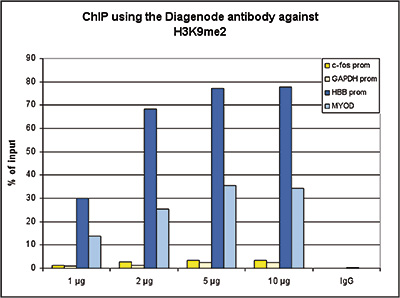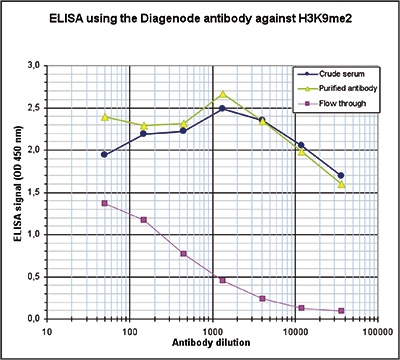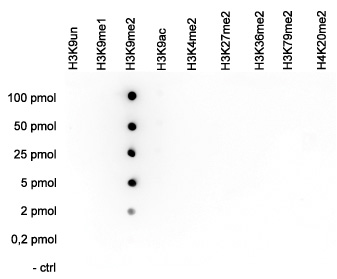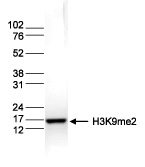
H3K9me2 Antibody
| 貨號 |
C15410060 |
售價(元) |
咨詢 |
| 規(guī)格 |
50ug |
CAS號 |
|
Polyclonal antibody raised in rabbit against the region of histone H3 containing the dimethylated lysine 9 (H3K9me2), using a KLH-conjugated synthetic peptide.
|
Lot
|
A90-0042
|
|
Concentration
|
1.15 μg/μl
|
|
Species reactivity
|
Human, mouse, Xenopus, Arabidopsis, C. elegans, Rice, Tomato, B. napus, Nicotiana benthamiana: positive. Other species: not tested
|
|
Type
|
Polyclonal
|
|
Purity
|
Affinity purified polyclonal antibody
|
|
Host
|
Rabbit
|
|
Storage Conditions
|
Store at -20°C; for long storage, store at -80°C. Avoid multiple freeze-thaw cycles.
|
|
Storage Buffer
|
PBS containing 0.05% azide and 0.05% ProClin 300
|
|
Precautions
|
This product is for research use only. Not for use in diagnostic or therapeutic procedures.
|
|
Applications
|
Suggested dilution
|
References
|
|
ChIP *
|
2 μg/ChIP
|
Fig 1
|
|
ELISA
|
1:1,000
|
Fig 2
|
|
Dot Blotting
|
1:20,000
|
Fig 3
|
|
Western Blotting
|
1:1,000
|
Fig 4
|
|
Immunofluorescence
|
1:500
|
Fig 5
|
* Please note that the optimal antibody amount per IP should be determined by the end-user. We recommend testing 1-5 μg per IP.
-
Validation Data
Figure 1. ChIP results obtained with the Diagenode antibody directed against H3K9me2
ChIP assays were performed using human HeLa cells, the Diagenode antibody against H3K9me2 (Cat. No. C15410060) and optimized PCR primer sets for qPCR. ChIP was performed with the “Auto Histone ChIP-seq kit, using sheared chromatin from 1 million cells. A titration of the antibody consisting of 1, 2, 5, and 10 μg per ChIP experiment was analysed. IgG (2 μg/IP) was used as negative IP control. QPCR was performed with primers specific for promoter of the inactive HBB gene and the coding region of the inactive MYOD gene, used as positive controls, and for the promoters of the active genes c-fos and GAPDH, used as negative controls. Figure 1 shows the recovery, expressed as a % of input (the relative amount of immunoprecipitated DNA compared to input DNA after qPCR analysis).
Figure 2. Determination of the antibody titer
To determine the titer of the antibody, an ELISA was performed using a serial dilution of the Diagenode antibody against H3K9me2 (Cat. No. C15410060), crude serum and Flow through. The antigen used was a peptide containing the histone modification of interest. By plotting the absorbance against the antibody dilution (Figure 2), the titer of the antibody was estimated to be 1:103,000.
Figure 3. Cross reactivity tests using the Diagenode antibody directed against H3K9me2
A Dot Blot analysis was performed to test the cross reactivity of the Diagenode antibody against H3K9me2 (Cat. No. C15410060) with peptides containing other modifications of histone H3 and the unmodified H3K9 sequence. One hundred to 0.2 pmol of peptide containing the respective histone modification were spotted on a membrane. The antibody was used at a dilution of 1:20,000. Figure 3 shows a high specificity of the antibody for the modification of interest.
Figure 4. Western blot analysis using the Diagenode antibody directed against H3K9me2
Histone extracts (15 μg) from HeLa cells were analysed by Western blot using the Diagenode antibody against H3K9me2 (Cat. No. pAb-060-050) diluted 1:1,000 in TBS-Tween containing 5% skimmed milk. The position of the protein of interest is indicated on the right; the marker (in kDa) is shown on the left.
Figure 5. Immunofluorescence using the Diagenode antibody directed against H3K9me2
Mouse NIH3T3 cells were stained with the Diagenode antibody against H3K9me2 (Cat. No. C15410060) and with DAPI. Cells were fixed with 4% formaldehyde for 10’ and blocked with PBS/TX-100 containing 5% normal goat serum and 1% BSA. The cells were immunofluorescently labeled with the H3K9me2 antibody (left) diluted 1:500 in blocking solution followed by an anti-rabbit antibody conjugated to Alexa488. The middle panel shows staining of the nuclei with DAPI. A merge of the two stainings is shown on the right.








